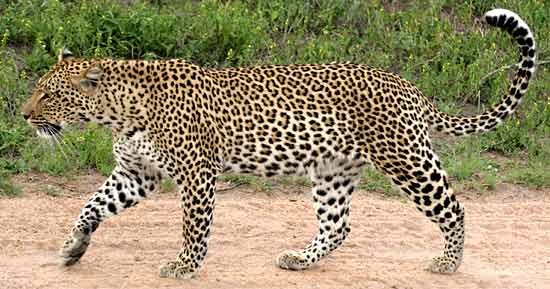
African Leopard Secrets Revealed
The African leopard has been revealed in a recent sophisticated study that documented the minute-to-minute behavior of the elusive big cat. For the first time this study uncovers the link to the cat’s caloric demands and their drive to kill. Chris Wilmers, associate professor of environmental studies at the University of California, Santa Cruz, led the team that studied the leopards’s predatory and reproductive behaviors by outfitting the cats with wildlife tracking collars equipped with GPS technology and an accelerometer to measure energy output.
African Leopards Whole Strategy is to be Elusive
African leopards are among the most elusive mammals on the planet even more so than African lions or cheetahs. “Their whole strategy is to be elusive,” said Wilmers. “People get glimpses of them, but that’s all. Looking at this data is like going on a safari for the first time and seeing an animal you’ve only seen in captivity before.”
The team gathered data from five leopards over a two month period. One adult male; one adult female with one cub; one adult female without cubs; one yearling male cub; and a young dispersal-aged male ready to establish his own territory. Even though the sample size is small, there is diversity of age and sex.
“Energetics is the ultimate currency for an animal’s survival,” said Wilmers. “To survive, an animal needs to balance the calories it’s expending with the calories it’s taking in. If it wants to reproduce, it has to run an energetic surplus.”
Wilmers, a wildlife ecologist who studies animal behavior and its cascading effects on ecosystems, said: “Based on what the leopards are doing, they run up different energetic budgets, which in turn influence their drive to kill. They might kill more prey, bigger prey, or go after more desirable prey in more dangerous places — closer to humans, for example.”

Information extracted from the collars permitted the team to match the leopards’ behavior with time and place, enabling them to determine the energetic costs of reproductive behavior, dispersal and territorial patrol for males and parenting for females. The study showed that male African leopards, territorial patrol activities use 26% of their daily caloric intake; for females, parenting a one-year old cub consumes 8% of her calories.
Fine-Tuned Energetics Data
These fine-tuned energetics data shine light on understanding the ecological consequences of the leopard’s drive to kill. Knowing the African leopard’s energetic needs allows researchers to evaluate where they hunt, what they hunt, and to estimate the level of risk they choose to take in pursuit of prey.
These factors have implications for humans and the livestock that share habitat with African leopards. The placement of a fence, for example, could have energetic “costs” for leopards if they have to travel farther, expending more energy to patrol territory, hunt, and provide for their offspring. Those costs would increase their drive to kill. “They might take bigger risks, they might catch larger prey like impala, and that could effect the impala population and what they feed on,” said Wilmers, outlining the “cascade” of ecosystem effects that could follow human changes to the landscape.
“To be able to link behavior to energetics to ecological effects is an important conceptual advance,” said Wilmers. “Once you understand how that circle works, we can assess how our actions will impact the animals, and how those effects will play out on the ecosystem.”
Story Source:
, , , and . 2017. Energetics-informed behavioral states reveal the drive to kill in African leopards. Ecosphere 8(6):e01850. 10.1002/ecs2.1850
This is an interesting and exciting study of the calorieactivity data for these fabulous, fierce cats. Fabulous photos as well.
This data will provide a nice first step in *beginning* to understand how our actions may impact the environment and related systems.
domino effect ~~~~~~~ is their status still considered “vulnerable” ??
photo one is amazing ??? be safe you cats???